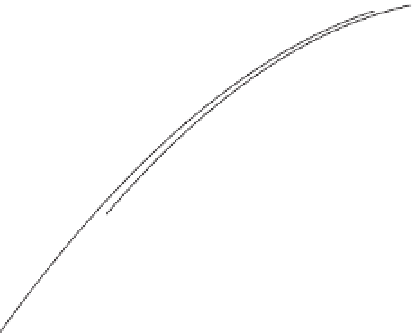Agriculture Reference
In-Depth Information
Reduction in maximum amino acid intake (%)
0
20
40
60
8
0
100
100
80
60
40
Met+Cys
Thr
20
0
Fig. 17.1.
Reduction in maximum body weight gain of male broilers as a proportion of the reduction in
intakes of methionine + cysteine (Met+Cys) and threonine (Thr) for the whole rearing period (42 days).
The analysed amino acid contents of the
feather-free body and feathers were, respect-
ively,
29
Met+Cys/kg and
54
g Met+Cys/kg
and
36
Thr/kg and
45
g Thr/kg.
In
Tables 17.4
and
17.5
the rates of pro-
tein deposition are presented together with
the body lipid contents of broilers fed
Met+Cys and Thr. Although there is no inter-
action between gender and level of Met+Cys
or Thr for these variables in some of the
phases studied, they are nevertheless pre-
sented separately, so that protein deposition
can be examined and hence the amino acids
for each gender, and the efficiency of amino
acid utilization for each sex can be evaluated.
In general, in all phases, the deposition
of protein increased with amino acid intake
until it reached a plateau
(Fig. 17.2
). The rate
of deposition of each amino acid (Met+Cys,
Thr) was calculated for each treatment during
each phase of the experiment taking account
of the content of amino acids in the protein
of body and feathers. Despite the differences
in rates of deposition between genders and
phases, the efficiency of utilization of Met+Cys
and Thr did not differ, being 0.56 (Met+Cys
d
=
28.01 + 0.56 Met+Cys
i
;
R
2
= 0.94) for Met+Cys
and 0.73 (Thr
d
= 10.87 + 0.73 Thr
i
;
R
2
= 0.91)
for Thr.
Body lipid content decreased as amino
acid intake increased
(Tables 17.4
and
17.5
).
The responses in body lipid to increasing
amino acid intake over the whole period
(
1-
42 days) for each amino acid are shown
in
Fig. 17.3
. Birds fed Met+Cys-limiting
feeds, at the end of 42 days, had less body
fat than those birds fed Thr-limiting feeds.
The fitted equations relating body
weight gain and body fat content to amino
acid intake are presented in
Tables 17.6
and
17.7
for Met+Cys and Thr, respectively.
Also shown in the tables are body weight
gain and body lipid content at the optimum
intake, as well as the calculated optimum
intakes of methionine + cysteine and threo-
nine when measured in males and females
in the starter, grower and finisher phases.
The estimated intakes for maximum BPd
(body protein deposition) are closer to those
estimated for maximal BWG. However, the
estimated requirements for minimum BLc
(body lipid content) are higher than those
for maximal BWG and BPd, this difference
being more pronounced in the older birds.
Other aspects of interest are the optimum
responses predicted by the models. BWG,
BPd and FCR are quite close to Met+Cys and
Thr in all phases, being closer with advancing














